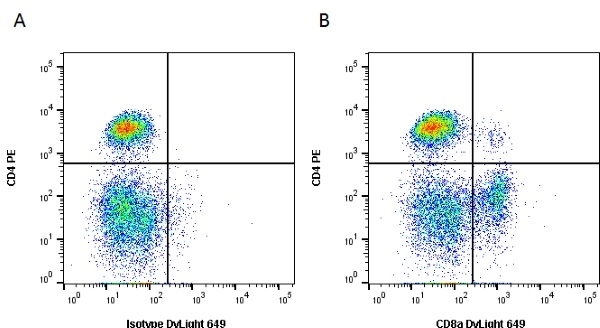CD8 Alpha antibody | CA9.JD3

Mouse anti Dog CD8 Alpha
- Product Type
- Monoclonal Antibody
- Clone
- CA9.JD3
- Isotype
- IgG2a
- Specificity
- CD8 Alpha
| Mouse anti Dog CD8 alpha antibody, clone CA9.JD3 recognizes the canine CD8 alpha chain which is expressed by thymocytes, peripheral T cells in the blood and lymphoid organs . Mouse anti Dog CD8α clone CA9.JD3 has been reported to inhibit cytotoxic T lymphocyte function (Cobbold et al. 1994). CA9.JD3 immunoprecipitates a heterodimer of ~32 kDa and ~36 kDa (reduced) from canine Tumor cells and from thymocytes. |
- Target Species
- Dog
- Product Form
- Tissue culture supernatant - liquid
- Preservative Stabilisers
- <0.1% sodium azide (NaN3)
- Immunogen
- Canine thymocytes.
- Fusion Partners
- Spleen cells from immunized Balb/c mice were fused with cells of the P3X63-Ag.653 myeloma cell line.
- Regulatory
- For research purposes only
- Guarantee
- 12 months from date of despatch
Avoid repeated freezing and thawing as this may denature the antibody. Storage in frost-free freezers is not recommended.
| Application Name | Verified | Min Dilution | Max Dilution |
|---|---|---|---|
| Flow Cytometry | Neat | ||
| Immunohistology - Frozen | Neat | 1/10 | |
| Immunoprecipitation |
- Flow Cytometry
- Use 10μl of the suggested working dilution to label 106 cells in 100μl
- Histology Positive Control Tissue
- Canine spleen, lymph node
| Description | Product Code | Applications | Pack Size | List Price | Your Price | Quantity | |
|---|---|---|---|---|---|---|---|
| Mouse IgG2a Negative Control | MCA929 | F | 100 Tests |
|
Log in | ||
| List Price | Your Price | ||||||
|
|
Log in | ||||||
| Description | Mouse IgG2a Negative Control | ||||||
Source Reference
-
Moore, P.F. et al. (1992) Monoclonal antibodies specific for canine CD4 and CD8 define functional T-lymphocyte subsets and high-density expression of CD4 by canine neutrophils.
Tissue Antigens 40(2): 75-85.
References for CD8 Alpha antibody
-
Cobbold, S. & Metcalfe, S. (1994) Monoclonal antibodies that define canine homologues of human CD antigens: summary of the First International Canine Leukocyte Antigen Workshop (CLAW).
Tissue Antigens. 43 (3): 137-54. -
Yuasa, K. et al. (2007) Injection of a recombinant AAV serotype 2 into canine skeletal muscles evokes strong immune responses against transgene products.
Gene Ther. 14: 1249-60. -
Veenhof, E.Z. et al. (2011) Characterisation of T cell phenotypes, cytokines and transcription factors in the skin of dogs with cutaneous adverse food reactions.
Vet J. 187 (3): 320-4. -
Lin Shiow-Chen et al. (2014) Immune Characterization of Peripheral Blood Mononuclear cells of the Dogs Restored from Innoculation of Canine Transmissible Venereal Tumor Cells.
Tai Vet J. 40 (04): 181-90. -
Constantinoiu, C.C. et al. (2015) Mucosal tolerance of the hookworm Ancylostoma caninum in the gut of naturally infected wild dogs.
Parasite Immunol. 37 (10): 510-20. -
Huyghe, S. et al. (2016) The Microscopic Structure of the Omentum in Healthy Dogs: The Mystery Unravelled.
Anat Histol Embryol. 45 (3): 209-18. -
Knebel, A. et al. (2021) Measurement of canine Th17 cells by flow cytometry.
Vet Immunol Immunopathol. 243: 110366. -
Bertolo, P.H.L. et al. (2022) Influence of serum progesterone levels on the inflammatory response of female dogs with visceral leishmaniosis.
Vet Parasitol. 302: 109658.
View The Latest Product References
-
Wesolowski, M. et al. (2023) Long-term changes of Th17 and regulatory T cells in peripheral blood of dogs with spinal cord injury after intervertebral disc herniation.
BMC Vet Res. 19 (1): 90.
- RRID
- AB_323370
- UniProt
- P33706
- Entrez Gene
- CD8A
- GO Terms
- GO:0016021 integral to membrane
MCA1999S
If you cannot find the batch/lot you are looking for please contact our technical support team for assistance.
Please Note: All Products are "FOR RESEARCH PURPOSES ONLY"
View all Anti-Dog ProductsAlways be the first to know.
When we launch new products and resources to help you achieve more in the lab.
Yes, sign me up